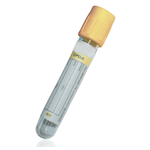Suitable Specimen Types
- Serum
Specimen Transport
Samples are sent To QE from the Heartlands, Good Hope and Solihull labsSample Processing in Laboratory
Usual
Sample Preparation
Separate serum and store at 2-8oC before transport to QE.Turnaround Time
7 daysSample Stability
2 weeks at 2-8oC (Abbott kit insert)Caeruloplasmin
General Information
Caeruloplasmin is an acute phase protein and transport protein. It belongs to the alpha-2 globulin electrophoretic fraction and contains 8 copper atoms per molecule. Incorporation of copper occurs during the synthesis of caeruloplasmim in hepatocytes. After secretion from the liver, caeruloplasmin migates to copper-requiring tissues where the copper is liberated during the catabolism of the caeruloplasmin molecule. In addition to transporting copper, caeruloplasmin has a catalytic function in the oxidation of iron, polyamines, catecholamines and polyphenols. Decreased concentrations occur in Wilson disease, an autosomal recessive hepatolenticular degeneration.
There are 2 defects of copper metabolism in Wilson disease:
- Impaired biliary excretion leading to copper deposition in the liver.
- Deficiency of caeruloplasmin leading to low plasma copper, deposition of copper in tissues and some excreted in urine.
Excessive deposition of copper in the basal ganglia of the brain and in the liver, renal tubules and eyes leads to neurological symptoms, liver damage leading to cirrhosis, renal tubular damage and Kayser-Fleischer rings at the edges of the cornea.
In Wilson disease the concentrations of caeruloplasmin and copper can be low with high urinary copper. Low caeruloplasmin is also found in active liver disease, protein loss syndromes, women on the OCP and during the last trimester of pregnancy. Wilson disease is a recessively inherited disease but heterozygotes may have low caeroluplasmin.
The rare Menkes' syndrome is a genetic copper absorption disorder with concomitant lowering of the caeruloplasmin concentration.
Increases in caeruloplasmin occur during acute and chronic inflammatory processes, as it is an acute-phase protein.
Patient Preparation
None
Notes
Please note this assay is now performed at QE.
An immunoturbidimetric assay. No significant interference from icterus, haemolysis or lipaemia. Rheumatoid factorsThere is no high dose hook effect up to caeruloplasmin concentrations of 5.00g/L
Samples are stable for 2 weeks at 2-8 oC or 3 months at -15 to -25 oC.
PLEASE NOTE: EDTA plasma samples are no longer accepted for caeruloplasmin analysis
Reference Range
0.2-0.6g/L
Source : Abbott Diagnostics
Specifications
-
EQA Status:
NULL
